_We may earn revenue from the products available on this page and participate in affiliate programs. Learn more ›
_
Best Overall
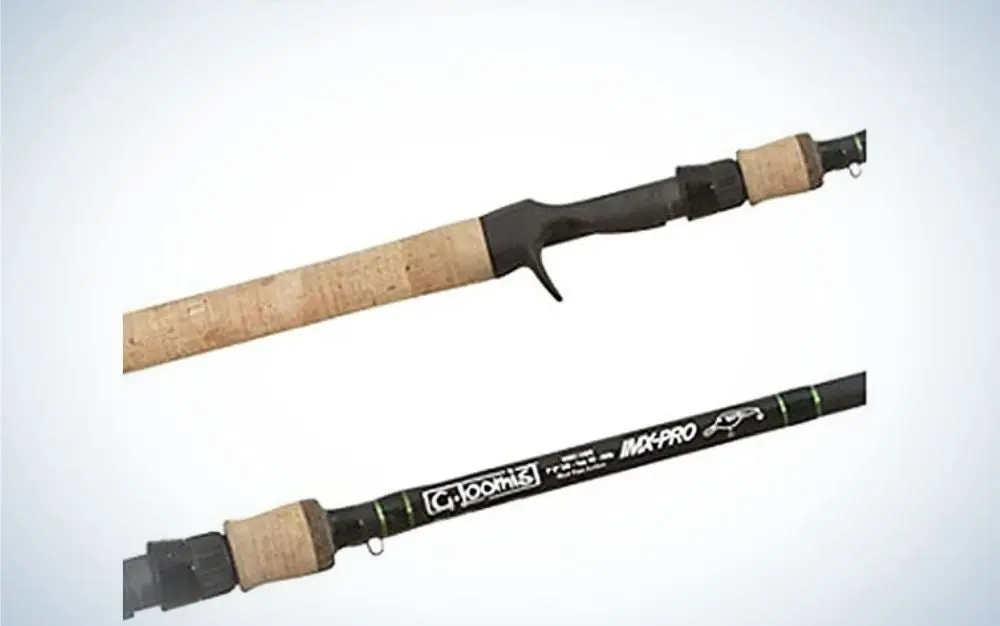
G. Loomis IMX-Pro Crankbait Casting Rod
LEARN MORE
Summary
Lightweight and powerful, this rod handles diving and lipless crankbaits, along with jerkbaits, with ease. It’s surprisingly good with topwaters, too.
Best Spinning
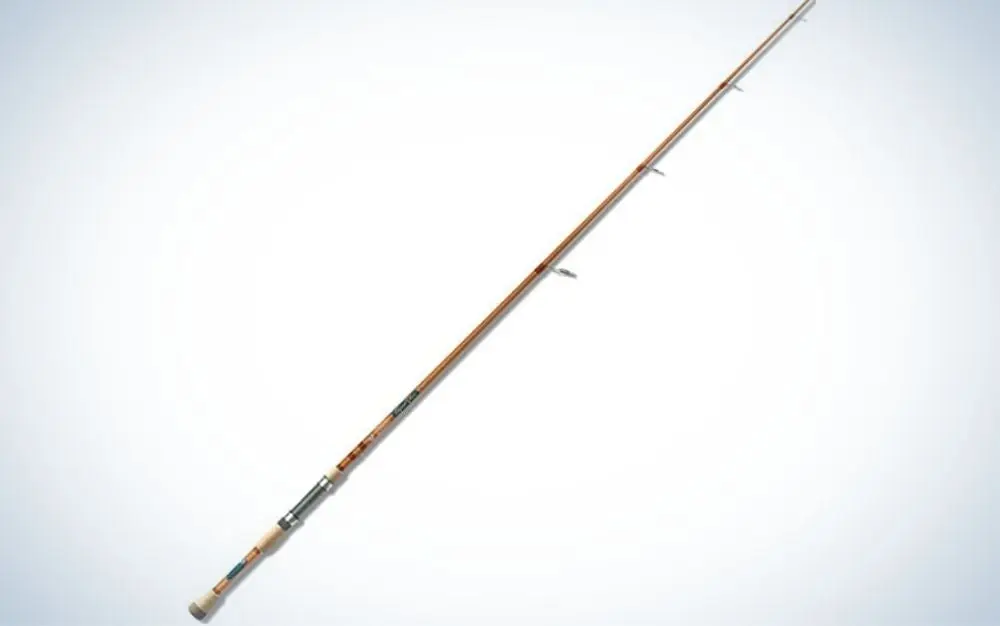
St. Croix Legend Glass Spinning Rod
LEARN MORE
Summary
You’ll be ready for the coldest days and smallest crankbaits with this fiberglass rod. Its blank has the perfect action for handling big bass while protecting light line and small hooks.
Best Budget
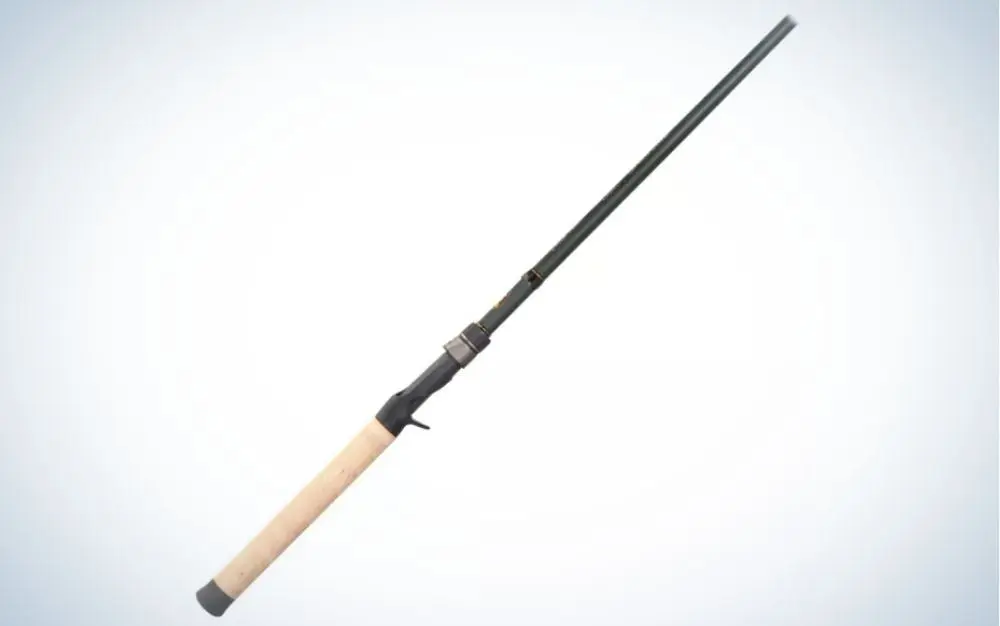
Lew’s David Fritts Perfect Crankbait Rod
LEARN MORE
Summary
This rod will catch fish without braking the bank thanks to its components and middle of the road length, power, and lure- and line-weight ranges.
Crankbait rods for bass share one trait—a parabolic bend. That flex, which is described as a slow or moderate action, stretches from tip to handle. It creates long casts, controls jumping and lunging bass, and leads to more productive fishing. But these rods aren’t all the same.
Crankbait rods were introduced in the late 1980s, when fast-action graphite blanks ruled the market. While sensitive and lightweight, their inflexibility made fishing crankbaits
and other treble-hooked lures difficult. So manufacturers slowed their action, creating the hallmark of a modern crankbait rod.
While the action of a fishing rod
is important, other traits determine a crankbait rod’s performance in particular fishing situations. Only when you sift through those will the best crankbait rods for bass be revealed.
Best Overall: G. Loomis IMX-Pro Crankbait Casting Rod
Best High-End: Megabass Destroyer P5 Z-Crank Elseil
Best Spinning: St. Croix Legend Glass Spinning Rod
Best for Deep-Diving Crankbaits: Dobyns Champion XP Glass
Best Budget: Lew’s David Fritts Perfect Crankbait Rod
How We Picked the Best Crankbait Rods
From murky Carolina reservoirs, where bass-fishing legends such as Buck Perry honed their craft, to the North’s natural rivers and lakes, and Mid-Atlantic’s tidal fisheries, I’ve encountered many bass fishing situations that call for crankbaits over the past 30 years. And each time, having the best crankbait rod made a difference.
Deciding which crankbait rods are best starts with asking plenty of questions. I’ve worked with and learned from industry professionals, who explained how materials and components are combined to create different actions and powers to ensure perfect presentations. As I’ve cultivated my information, and manufacturers refined and expanded their options, my idea of the best crankbait rods has evolved.
Watching your tournament partner lose bass, which were all too eager to eat his crankbait, on four consecutive casts because his rod’s action was too fast, shapes your selection process, too. As does discovering a medium-heavy power rod pops lipless crankbaits free from submerged aquatic vegetation and into a prespawn bass’s mouth and a long rod ensures your deep-diver reaches a brush pile, where at least two 3-pounders live. The more factors you can put in your favor, the more success you’ll enjoy. I based my selections on the following criteria:
Length: How long is the rod and is it a good length to cast crankbaits?
Materials: What is the rod blank made from? Fiberglass? Graphite? Or a blend?
Power: What is the rods action and what can it withstand?
Lure Compatibility: Does the rod do a good job of throwing crankbaits?
Best Crankbait Rods: Reviews & Recommendations
Best Overall: G. Loomis IMX-Pro Crankbait Casting Rod
Best Overall

Specs
Length: 7 feet
Power: Medium heavy
Line and Lure Weights: 10- to 20-pound test, 3/8 to 1 ounce
Pros
Handles a wide range of lure and line weights
Medium-heavy power casts well and whips big bass
Lightweight and sensitive
Cons
Length is a bit short for effective deep-water fishing
Heavier reel required to achieve balance
This IMX-PRO is a true multitasker thanks to its smart design. It’s high-modulus graphite blank is reinforced only where needed, reducing overall weight and making it a pleasure to fish all day. As a bass fishing rod
, it’s extremely sensitive, clearly announcing the softest bite when fishing jerkbaits for cold water bass.
Handcrafted in the United States and sporting a full grip cork handle, it loads easily and smoothly, launching lures farther than most 7-footers. Its medium-heavy power sets hooks at the end of long casts and turns big bass. Plus, it’s an outstanding buzzbait rod. Power and action team to cast these aerodynamically challenged lures a decent distance. And setting the hook involves a delay as it moderate-action loads, so you’re less likely to pull your buzzbait away before a bass has it.
This rod can feel tip heavy when casting lures close to its 1-ounce maximum, though choosing a slightly heavier baitcasting reel will bring it back into balance. And its 7-foot length may leave you wishing for something longer when fishing big water, where long casts help crankbaits dive deeper.
Best High-End: Megabass Destroyer P5 Z-Crank Elseil
Best High-End
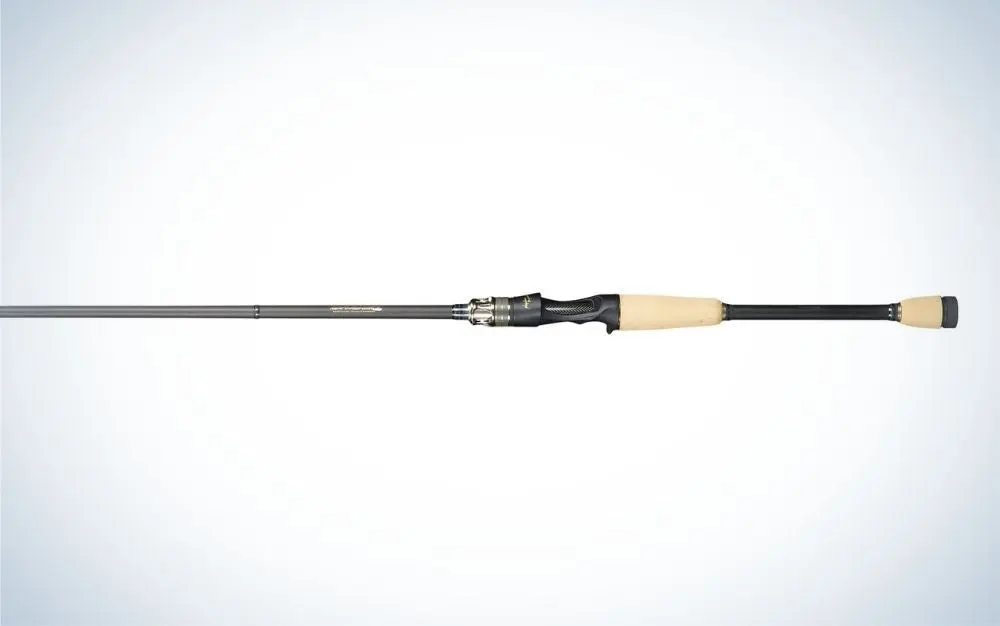
Megabass Destroyer, P5 Z-Crank Elseil Megabass USA
Specs
Length: 7 feet
Power: Medium
Line and Lure Weights: 8- to 16-pound test, 1/4 to 3/4 ounce
Pros
Light weight increases overall performance
Blank’s precise taper increases casting accuracy
Top-shelf craftsmanship
Cons
Lacks the ability to handle big crankbaits
Whether you’re twitching a Vision 110 jerkbait or handling this rod, it’s easy to see and feel the thought and passion Yuki Ito builds into his Megabass
products. They’ve led the fishing industry for decades and the Destroyer is the brand’s top line of rods. Match it with a compact high-performance baitcasting reel, such as Daiwa’s Steez SV TW, spooled with fluorocarbon line, and you’ll have the ultimate crankbait setup.
Its 5D graphite system is extremely sensitive. Weighing 3.7 ounces, it has the industry’s best power-to-weight ratio. Its snappy action quickly recovers, helping launch long casts and pop crankbaits free of snags, especially in aquatic vegetation, while maintaining the flex required to present lures sporting treble hooks.
It handles small lipless crankbaits, jerkbaits, and topwaters and shines with small diving crankbaits, such as Bandit’s 200 Series, which is perfect for fall bass fishing. But its medium power and lure and line weight ranges make it a poor choice for pulling larger crankbaits across spots in deeper water during summer.
Best Spinning Rod: St. Croix Legend Glass Spinning Rod
Best Spinning Rod

St. Croix Legend Glass, LGS610MM St. Croix Rods
Specs
Length: 6 feet, 10 inches
Power: Medium
Line and Lure Weights: 6- to 12-pound test, 1/4 to 5/8 ounce
Pros
Designed to cast lightweight lures
Fiberglass blank’s slow action supports light line and small hooks
Spinning configuration easier to use in cold weather
Cons
Length limits casting distance
Reel seat can feel uncomfortable
This St. Croix crankbait rod stands alone—in applications and design. Its SCI Linear S-glass blank, whose uniform wall thickness and smooth action are the results of proprietary technology, is a modern twist on traditional rod-building material. It’s lighter than most fiberglass rods, and its one-piece design adds sensitivity.
Its moderate action is perfect for casting small plastic and balsa crankbaits, including Rapala’s No. 7 Shad Rap, which weighs 5/16 ounces. While that lure excels at catching bass in cold water, it’s a struggle to fish on baitcasting gear. And spinning rods mean no backlashes, which are difficult to clear with fingers numbed by cold water or covered in gloves.
It’s 6-feet, 10-inch length is short on casting distance, which you probably will miss while casting to a point or flat. It’s reel seat can also feel uncomfortable to bare hands.
Best for Deep-Diving Crankbaits: Dobyns Champion XP Glass Crankbait Rod
Best for Deep-Diving
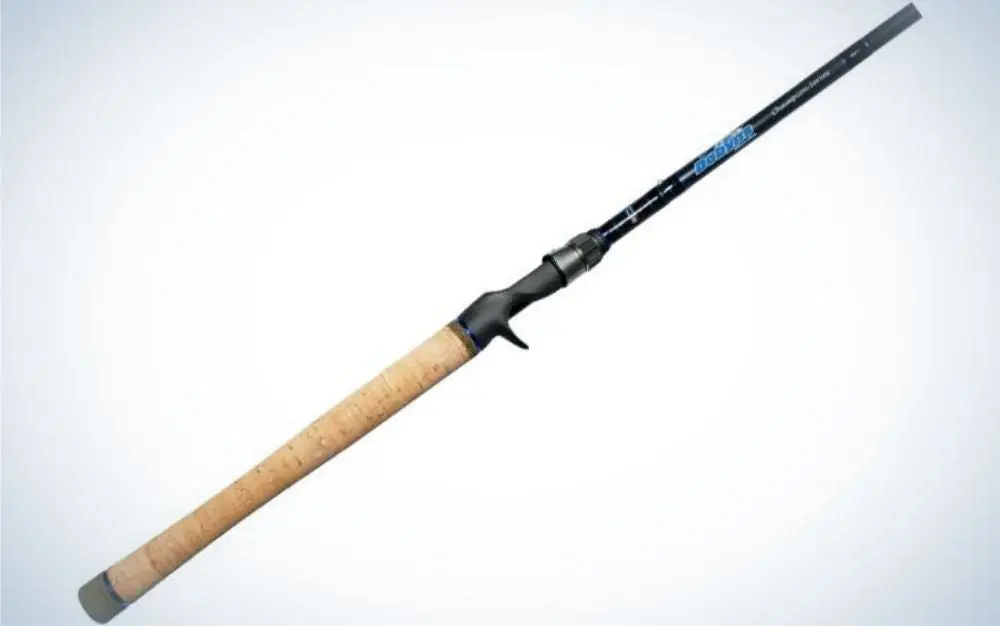
Dobyns Champion XP Glass, DC 805 CB GLASS Tackledirect
Specs
Length: 8 feet
Power: Medium heavy
Line and Lure Weights: 10- to 20-pound test, 3/8 to 1 1/2 ounces
Pros
8-foot length creates long casts
Medium-heavy power easily handles big lures and lines
15-inch handle provides relief during all-day cranking sessions
Cons
Limited applications
Longer length can feel unwieldy
Big deep-diving crankbaits, such as Norman’s DD22 or Strike King’s 8XD and 10XD, demand a big rod. This workhorse, designed by the West’s leading bass tournament money winner, Gary Dobyns, performs like a thoroughbred.
As soon as you grab it, you’ll notice that it feels light for an 8-foot fiberglass rod
. It only will take until the first cast to witness its performance. Built on a fine-tuned blank, its length and medium-heavy power combine to launch crankbaits the proverbial country mile. And it’s sensitive, telegraphing your crankbait’s every move, despite its classic moderate action, which removes the slack line and leverage that bass use to throw heavy crankbaits. Its cork handle measures 15 inches; clamp it between your arm and torso to relieve the hand and wrist pressure that comes with grinding hard-pulling crankbaits.
This rod may seem like a one-hit-wonder, sounding best to anglers regularly fishing the legendary ledges of Tennessee River impoundments. But it can do more, once you get used to handling its length. It’ll fish big swimbaits, whose hookup ratio benefits from the delay of a slow-action rod, and lob unwieldy umbrella rigs.
Best Budget: Lew’s David Fritts Perfect Crankbait Rod
Best Budget

Lew’s David Fritts Perfect Crankbait Rod, LDFP70M Bass Pro Shop
Specs
Length: 7 feet
Power: Medium
Line and Lure Weights: 10- to 25-pound test, 3/8 to 1-ounce
Pros
Crankbait-centric design
Handles a range of lure and line weights
Components contribute to long casts
Cons
Struggles with lightweight lures
Overall weight is heavier than most 7-foot cranking rods
Few professional bass tournament anglers are more closely tied to one lure than David Fritts to crankbaits. The North Carolinian cut his teeth on Piedmont reservoirs, learning to make crankbaits tick and bass bite them. A fan of Lew’s reels for decades, it was only natural the two would team up on a rod purpose-built for fishing crankbaits.
Its blank is a mix of 42-million modulus graphite and fiberglass, which adds sensitivity while preserving the all-important moderate action. Fritts says its narrow stainless steel line guides, which have aluminum oxide inserts, extend casting distance. And its loop-style keeper was designed to quickly lock down and release treble hooks.
Its 7-foot length can attack shallow-water cover and is a player on summertime spots in big water. While it will handle a variety of lures—crankbaits, jerkbaits, and topwaters—up to 1 ounce, it struggles with ones at the lighter end of its range. Those lack enough mass to fully load its blank, cutting casting distance and accuracy. And even though you’ll leave the tackle shop with money in your hand, this rod’
s 6.6 ounces means you also will be left holding extra weight, compared to most 7-footers. That’s the economics of less expensive rods.
What to Consider When Choosing a Crankbait Rod
While rods designed for bass jigs
, soft-plastic bass lures
, and spinnerbaits have fast actions, only flexing at their tip, you’re guaranteed to find a slow action in ones engineered specifically for crankbaits. So, their performance will be defined by other attributes. Turn your attention to these.
Length
Casting distance, lure presentation, and how many bass land in your boat are dictated to a large degree by a crankbait rod’s length. Available in increments from 6 feet to 8 feet, each one shines in particular bass-fishing scenarios.
6- to 7-feet long: Use these to quietly and accurately place your crankbait around and in shallow-water targets such as laydowns, aquatic vegetation, and points along riprap. They also are best at handling jerkbaits, poppers, and other lures worked with downward snaps of your rod.
7- to 7-feet, 6 inches long: These rods make short casts to the bank and long casts offshore equally well. They can rip lipless crankbaits from submerged aquatic vegetation, drawing reaction strikes, and present jerkbaits and big topwaters such as Zara Spooks and Whopper Ploppers.
7 1/2- to 8-feet long: Capable of launching lures great distances, these rods are best offshore. They can give deep-diving crankbaits, for example, enough room and space to reach their maximum depth. Accuracy isn’t a strong suit.
Blank
Blanks are the backbone of spinning and baitcasting rods. The best crankbait rods use blanks made of one or two of the materials below. Each affects a rod’s overall weight, sensitivity, and price.
Fiberglass: This old-school woven material is flexible, creating the smoothest parabolic bend. Rods made with fiberglass blanks often weigh the most but cost the least. It’s the pick of crankbait purists.
Graphite: Sheets of this crystalline form of carbon are rolled and baked to produce blanks. They’re lightweight, extremely sensitive, and powerful.
Blend: A mix of fiberglass, which provides the perfect action, and graphite, which adds sensitivity and subtracts weight. It can be a good compromise for specific situations.
Lure- and Line-Weight Ranges
Slow or moderate action rods can be persnickety about the lures and lines that they handle. Casting is difficult with too light of a lure because it won’t fully load the rod. And accuracy disappears with a rod that’s too heavy. That’s why crankbait rods perform best when lure and line are within their respective weight ranges. Those are closely associated with a rod’s power, which describes the force that it can handle.
Small Crankbaits: These typically weigh between 1/4 and 3/8 ounce and include small balsa crankbaits, such as Rapala’s Shad Rap, plastic ones, like Cotton Cordell’s midsized Big O, and jerkbaits such as Lucky Craft’s Pointer 78. Lines from 6- to 10-pound test and light or medium powers are best.
Medium Crankbaits: These typically weigh between 3/8 and 5/8 ounce and include Norman’s Deep Little N and Rapala’s DT-8 and DT-10. Lipless crankbaits weighing 1/2 ounce and larger jerkbaits, such as Spro’s McStick 110, are in this group, too. They perform best on 8- to 15-pound test lines and medium or medium-heavy powers.
Deep-Divers: These include 6th Sense’s C20 Cloud 9 and Berkley’s Dredger 20.5. They can weigh upwards of 2 ounces and pull hard, so rods with a medium-heavy or heavy action and strong lines are required. Braided line, for example, packs more strength into a smaller diameter than monofilament or fluorocarbon lines, allowing it to more efficiently cut through the water and fish deeper.
Components
Handles, grips, and line guides contribute to a crankbait rod’s performance. But personal preference can play the biggest role in choosing them.
Handle: Foam handles are comfortable but can be slippery when wet. Cork handles offer a firmer hold and are lighter and more sensitive.
Grip: Full grips extend from reel seat to rod butt. They’re usually found on the biggest crankbait rods. Split grips, which expose a portion of blank between the reel seat and fighting butt, are more popular with bass anglers and reduce a rod’s overall weight.
Line Guides: Choose ones made from a durable material and inspect them regularly. Crankbaits create plenty of resistance, which can grind the line into guides and may even cut line-eating grooves into them.
FAQs
Q: What is a crankbait rod?
A crankbait rod is specifically designed to throw lures made from wood or hard plastic that are equipped with treble hooks, including diving and lipless crankbaits, jerkbaits and many topwaters. While most crankbait rods measure between 6- and 8-feet long, all have a slow—sometimes labeled moderate—action, smoothly flexing from tip to handle. They’re available in a variety of powers; some easily cast lightweight balsa crankbaits, for example, while others muscle deep-diving ones that weigh more than one ounce. Most are offered as baitcasting rods, though some manufacturers offer spinning versions.
Q: Why is a specific rod needed for crankbaits?
A specific rod is needed for crankbaits for two main reasons. First, crankbaits are outfitted with treble hooks. Unlike single-hook lures, such as jigs and spinnerbaits, trebles spread the force applied by the angler across six or more points. That dilutes pressure, leading to less effective hook sets and making it easier for jumping and lunging bass to throw a crankbait. Slow-action crankbait rods function as a shock absorber, keeping your line tight and hooks set regardless of a bass’s actions. Secondly, slow-action rods need time to load, creating a delay between the angler pulling and hooks setting. That allows just enough time for most bass to fully engulf a crankbait, leading to more hookups.
Q: What’s a good rod for deep-diving crankbaits?
A good rod for deep-diving crankbaits is long, has a medium-heavy power and slow action. Its length—7 1/2 to 8 feet—increases casting distance. That creates time and space for a crankbait to reach its maximum diving depth. Its power stands up to long-billed crankbaits, some of which dig well past the 20-foot mark, and working in tandem with a slow action, tames the big bass that live there. They also have a long full grip. Deep-diving crankbaits pull hard, so squeezing it between your arm and torso will relieve pressure on your wrist and hand, allowing you to fish longer and more comfortably.
Q: What is the best color of crankbait?
The best color of a crankbait depends on water clarity. Three patterns cover nearly all bass fishing situations. Shad ones work best in clear water. Crawfish ones work in clear and stained water, and highly visible fire tiger is best in muddy water. There are variations of each, so it’s easy to fine-tune your lure’s color to specific situations. Prespawn bass, for example, can find craw patterns that incorporate orange, chartreuse or red easier than traditional brown versions in spring, when runoff stains water and they bury in submerged aquatic vegetation.
Best Crankbait Rods: Final Thoughts
Best Overall: G. Loomis IMX-Pro Crankbait Casting Rod
Best High-End: Megabass Destroyer P5 Z-Crank Elseil
Best Spinning Rod: St. Croix Legend Glass Spinning Rod
Best for Deep-Diving Crankbaits: Dobyns Champion XP Glass Crankbait Rod
Best Budget: Lew’s David Fritts Perfect Crankbait Rod
Fishing is good but catching is best. And when it comes to using crankbaits and other lures sporting treble hooks, you’ll do more of the latter by choosing the best crankbait rods, whose length, power, and ranges of lure and line weights match your specific fishing situation. That can be getting the most bass for your bucks with Lew’s David Fritts Perfect Crankbait Rod
, tackling a bit of everything with the G. Loomis IMX-PRO
, or seeking perfection with a Megabass Destroyer
.
Why Trust Us
For more than 125 years, Field & Stream has been providing readers with honest and authentic coverage of outdoor gear. Our writers and editors eat, sleep, and breathe the outdoors, and that passion comes through in our product reviews. You can count on F&S to keep you up to date on the best new gear. And when we write about a product—whether it’s a bass lure or a backpack—we cover the good and the bad, so you know exactly what to expect before you decide to make a purchase.
![Field & Stream [dev]](https://images.ctfassets.net/fbkgl98xrr9f/1GnddAVcyeew2hQvUmrFpw/e4ca91baa53a1ecd66f76b1ef472932b/mob-logo.svg)




